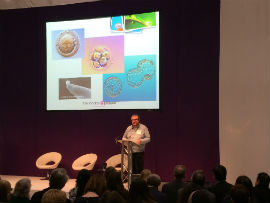On February 8th, 2015, at the “100% Optical” networking seminar in London, Professor Pete Coffey addressed a packed conference room.
Expert, Professor Pete Coffey, from the University College London Institute for Ophthalmology, gave attendees an insight into the cutting edge research being carried out to treat blinding retinal conditions with his talk, entitled Stemming vision loss using stem cells.
Professor Coffey, who is director of the London Project to Cure Blindness, described the basis of cellular therapies and told delegates how the grandly titled project aims to use a patient’s own cells to restore their degenerating retinas and treat their vision loss. And the project is well on its way to realizing these ambitions. Emphasizing why such treatments are needed, he reminded practitioners of the devastating impact of age-related macular degeneration (AMD) – for which there is currently no treatment – has on patients’ lives. He said: “You lose your ability to focus. You lose your ability to read, drive, or even recognize your loved ones.”
The approach focuses on replacing the dead and dying cells in the central retinal layer, the retinal pigment epithelium (RPE). “The RPE is crucial to the health of the macula,” said Professor Coffey. “If we can get RPE back under the retina, we can save people’s vision. We can stop people going blind.”
The operation is a delicate procedure taking three hours, and the approach has been successful so far. Patients who have received the cell transplant being able to see additional lines on a Snellen chart, and regaining 6/12 vision.
Professor Coffey described the challenges to date, including the need for an artificial membrane in order to help the cells survive. However, the group is no longer reliant on embryos as a sole source of cells. With the advent of induced pluripotent stem cells (IPSCs), clinicians have been gifted a method of treating a patient using RPE grown from their own reprogrammed skin cells.
The ultimate aim is to make the process a standard outpatient procedure similar to a cataract operation, taking only 20 minutes. From April this year, a number of patients will receive the treatment at Moorfields. In patients with retinal tear and bleeds, the build up of fluid can lead to death of the RPE and blindness in as little as six weeks. But if the patch of RPE cells received by patients stops them from going blind, researchers will know it works. Next on the list is then dry AMD.
“It really could be a standard outpatient procedure,” added Professor Coffey, describing the potential for 70% of patients to have the procedure while still awake. He also offered the savings for the National Health Service which could be made if the approach became commonplace. Ten years ago, 40 patients were operated on at a cost of approximately £4,000 each, and 16 of these saw a sustained improvement. Based on estimates of the cost of blindness from the World Health Organization, at £15,000 per person per year, the approach could have saved more than £2m for the NHS on these 16 patients alone.
The project is now working with a Japanese group to manufacture the biomedical component needed for the operation, which will simplify and standardize the operation and drive costs down further. The researchers plan to create a chip, comprising the stem cells and an artificial membrane, for a cost of just £400.
Article Source: http://www.optometry.co.uk
Professor Pete Coffey spoke on the main stage at 100% Optical, which was held at the ExCeL Exhibition Centre, in London, on February 7–9.
Tags: eye disease treatment, stem cell therapy for AMD, treating AMD, treating macular degeneration






